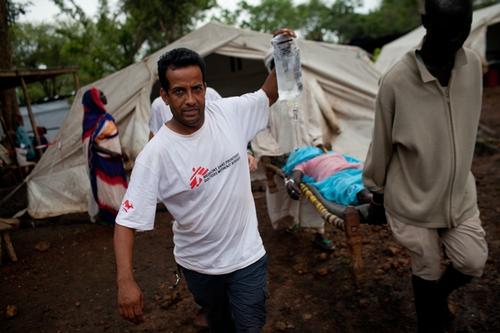HIV: The innovative project reaching rural communities in South Africa
South Africa’s KwaZulu-Natal Province has the highest rates of HIV and tuberculosis (TB) in the country.
Since 2011, Médecins Sans Frontières / Doctors Without Borders (MSF) has been running an innovative project in the deeply traditional areas of Eshowe and Mbongolwane to help reduce deaths and new infections from these two diseases.
The project works with government and traditional authorities to pilot and adapt a ‘model of care’ that is driven by the community.
The hilly landscape in this part of South Africa makes it difficult for many people to access healthcare services.
However, MSF has been able to take care directly into communities.
Initially, this was done by going door-to-door, but more recently by establishing rural healthcare hubs known as 'Luyanda sites'.
These Luyanda sites have been established in spaces where people in rural areas congregate. They offer HIV counselling and testing, TB services and also screening for non-communicable diseases (also known as chronic diseases) such as diabetes and hypertension.

Help us prepare for the next emergency
In numbers: Our work on HIV/AIDS
39 million
PEOPLE LIVING WITH HIV WORLDWIDE
75%
OF PEOPLE WITH HIV RECEIVE ANTIRETROVIRAL THERAPY
44,500
PEOPLE ON FIRST-LINE HIV TREATMENT UNDER MSF CARE IN 2023
In 2019, the project became the first in South Africa to achieve the ambitious UNAIDS 90-90-90 target for HIV.
This is the goal that 90 percent of people with HIV will know their status, 90 percent will receive regular antiretroviral treatment and 90 percent of people receiving treatment will have the virus suppressed.
From 2020, the project has also been focused on following a similar strategy to tackle TB rates in the region. The Luyanda sites will be a key tool to achieving this and, ultimately, save more lives.
MSF and HIV/AIDS
HIV (human immunodeficiency virus) damages the cells in your immune system and weakens a person’s ability to fight everyday infections and disease.
There's currently no cure for HIV, but there are very effective treatments that enable most people with the virus to live a long and healthy life.
In 2020, Médecins Sans Frontières/Doctors Without Borders (MSF) cared directly for 63,500 people on first-line HIV antiretroviral treatment.